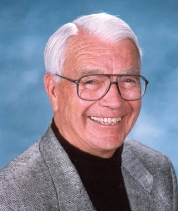April 11, 1970: Apollo 13 hurtles into space.
April 13, 1970: An oxygen tank onboard explodes, and NASA asks Donald Harvey ’52 to help bring the astronauts home.
“That explosion caused loss of critical systems in the service module—the propulsion system, fuel cells, guidance system,” said Harvey, who worked for TRW. “It was rendered useless, so they decided to use the lunar excursion module as a lifeboat to provide the propulsion to return to Earth. As the lead engineer on the lunar module descent engine, I provided technical assistance to NASA regarding what the LMDE could and could not do.”
The situation was dire. Power, water and carbon dioxide buildup were serious concerns, and engineers had to quickly write and test entirely new procedures.
Harvey relied on test data and thermal modeling to evaluate the integrity of the LMDE under various rocket firing scenarios. The LMDE rockets ultimately fired three times to bring Apollo 13 back.
“I felt a great deal of pressure, but I had the support of a great engineering staff,” said Harvey, who was assigned to the Manned Space Craft Center in Houston for the Apollo 11 through 17 missions. “I was told when I checked in that I couldn’t leave until the crisis was over. I thought, ‘Who would think of leaving until the astronauts are safe on Earth?’”
In an incredible feat of human ingenuity, Apollo 13 splashed down in the Pacific Ocean on April 17, about 87 hours after the explosion.
Harvey has only one word to describe how he felt at that moment: “Awesome!”

